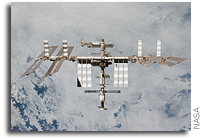International Space Station Team Receives 2009 Collier Trophy

The 2009 Robert J. Collier Trophy has been presented to NASA and the International Space Station Team by the National Aeronautic Association. The Collier Trophy is awarded annually “for the greatest achievement in aeronautics or astronautics in America, with respect to improving the performance, efficiency, and safety of air or space vehicles, the value of which has been thoroughly demonstrated by actual use during the preceding year.”
The 2009 Trophy recognized NASA and the International Space Station Team of The Boeing Company, Draper Laboratory, Honeywell Corporation, Lockheed Martin Corporation (NYSE:LMT – News), United Space Alliance and United Technologies Corporation “for the design, development and assembly in space of the world’s largest spacecraft, an orbiting laboratory, promising new discoveries for mankind and setting new standards for international cooperation in space.”
Robert J. Collier was a prominent publisher whose family created the popular Colliers Weekly, in addition to being an aviator, humanitarian, and sportsman. He commissioned the trophy in 1910 with the intent to encourage the American aviation community to strive for excellence and achievement in aeronautic development. In recognizing the worth and future of aviation, Collier proclaimed the ideal that, “the flying machine should be unselfishly and rapidly developed to its ultimate potential for economic advancement in America.” In support of his statement, Collier was the first person to purchase an airplane from the Wright brothers for personal use.
“It is humbling to be a part of the International Space Station Team upon which this exceptional award was conferred and that now takes its place alongside so many of the pioneers of aeronautics and astronautics who preceded us in receiving this distinguished honor,” said Jim Crocker, vice president & general manager of Sensing & Exploration Systems at Lockheed Martin Space Systems Company (LMSSC). “The International Space Station program is a prime example of how exceedingly difficult endeavors can be accomplished through teamwork, determination and a commitment to excellence, and we are enormously proud to be a member of the team.”
The four pairs of solar array wings that power the Space Station were constructed by LMSSC at its Sunnyvale, Calif. facility. The Space Systems’ ISS solar arrays are the largest deployable space structures ever built and are by far the most powerful electricity-producing arrays ever put into orbit. The eight flexible, deployable solar array wings generate the reliable, continuous power required for the on-orbit operation of the ISS systems. The ISS arrays were designed and built under a $450-million contract from The Boeing Company. Boeing is the prime contractor to NASA, and is responsible for design, development, construction and integration of the ISS.
Each of the eight wings consists of a mast assembly and two solar array blankets. The blankets each have 84 panels, of which 82 are populated with solar cells. Each panel contains 200 solar cells. The eight photovoltaic arrays thus accommodate a total of 262,400 solar cells. Fully deployed in space, the active area of the eight wings – each 107 by 38-feet – encompass an area of 32,528-square feet.
In addition to the arrays, Space Systems in Sunnyvale designed and built other elements for the Space Station. Two Solar Alpha Rotary Joints – each 10.5 feet in diameter and 40 inches long – were delivered to ISS in 2006 and 2007, and maintain the arrays in an optimal orientation to the sun while the entire space station orbits the Earth once every 90 minutes. A pair of Thermal Radiator Rotary Joints – each five and one-half feet long and three feet in diameter – was launched in 2002, and maintains Space Station thermal radiators in an edge-on orientation to the sun that maximizes the dissipation of heat from the radiators into space.
Space Systems also produced the Trace Contaminant Control System – launched to ISS as an element of the U.S. Destiny Laboratory module in 2001 – an advanced air processing and filtering system that ensures that over 200 various trace chemical contaminants, generated from material off-gassing and metabolic functions in the Space Station atmosphere, remain within allowable concentration levels. It is an integral part of the Space Station’s Cabin Air Revitalization Subsystem.
Lockheed Martin Space Systems Company, a major operating unit of Lockheed Martin Corporation, designs and develops, tests, manufactures and operates a full spectrum of advanced-technology systems for national security and military, civil government and commercial customers. Chief products include human space flight systems; a full range of remote sensing, navigation, meteorological and communications satellites and instruments; space observatories and interplanetary spacecraft; laser radar; ballistic missiles; missile defense systems; and nanotechnology research and development.
Headquartered in Bethesda, Md., Lockheed Martin is a global security company that employs about 136,000 people worldwide and is principally engaged in the research, design, development, manufacture, integration and sustainment of advanced technology systems, products and services. The Corporation reported 2009 sales of $45.2 billion.
Media Contact: Buddy Nelson, (510) 797-0349; e-mail, buddynelson@mac.com









